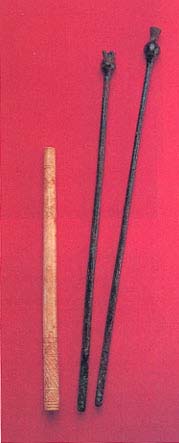Image Details

Nahum Slapak, courtesy of the Israel Museum, Jerusalem
A crop of scepters, harvested from Tel Nami. Decorated with incised designs, the ivory scepter, left, came from a robbed grave. Unfortunately, the scepter lacks its head, and it was not found in the grave itself. An unrobbed grave 15 feet away, however, yielded two bronze scepters, center and right. Though dating to the 13th or early 12th century B.C.E., the foot-long scepters are well preserved. Indeed, when first excavated, one appeared to bear traces of silver sheeting, which unfortunately disintegrated when exposed to air. The head of one scepter, center, represents a pomegranate, while the other scepter head may represent either a poppy seed pod or a pomegranate. Archaeologists found the scepters lying upon the skeleton of a man who may have been a priest.
